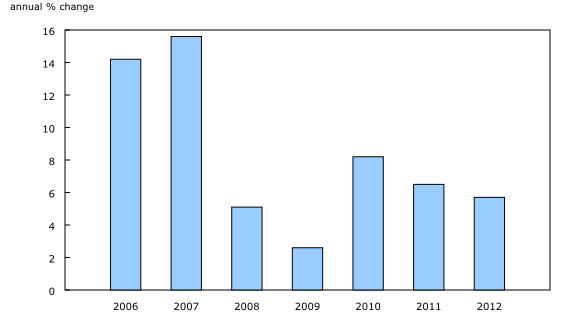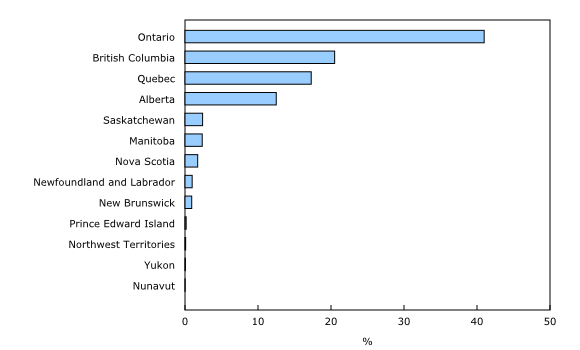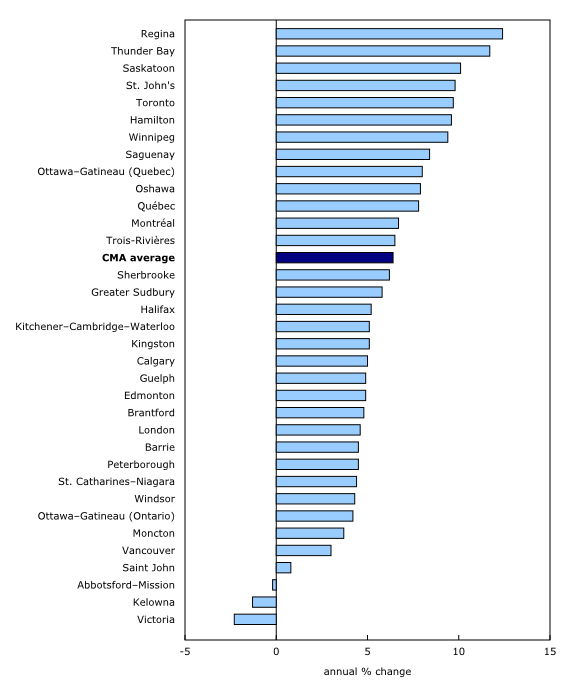Residential property values, 2012
Archived Content
Information identified as archived is provided for reference, research or recordkeeping purposes. It is not subject to the Government of Canada Web Standards and has not been altered or updated since it was archived. Please "contact us" to request a format other than those available.
Released: 2015-07-07
$4,065 billion
2012
5.7% 
(annual change)
The total market value of residential properties in Canada was $4,064.5 billion in 2012, up 5.7% from 2011.
Much of the increase in value occurred in Ontario, Alberta and Quebec. Together, these three provinces accounted for 83.8% of the annual increase.
Growth in residential property values was slower in 2012 than the previous year, but remained above the rate observed during the economic slowdown in 2009.
Residential property values concentrated in four provinces
In 2012, four provinces accounted for more than 90% of total national residential property values: Ontario (41.0%), British Columbia (20.5%), Quebec (17.3%) and Alberta (12.5%).
Saskatchewan leads provincial residential property value growth
Among the provinces, the highest growth rates were found in Saskatchewan (+9.7%), Newfoundland and Labrador (+9.5%) and Manitoba (+8.8%).
The lowest rates of change in property values were in British Columbia (+1.3%) and Nova Scotia (+3.5%).
Values grow in nearly every census metropolitan area
The total value of all residential properties in census metropolitan areas (CMAs) increased 6.4% between 2011 and 2012. Regina (+12.4%) increased the most, followed by Thunder Bay (+11.7%) and Saskatoon (+10.1%).
The total value declined in Victoria (-2.3%), Kelowna (-1.3%) and Abbotsford–Mission (-0.2%).
Toronto, Vancouver and Montréal account for almost half of total residential property values
The value of the residential stock held in Canadian CMAs totalled $3,103.5 billion in 2012, representing over three-quarters (76.4%) of the national total.
Toronto, Vancouver and Montréal, the three largest CMAs in terms of residential property values, accounted for 44.4% of Canada's total in 2012.
The other CMAs combined made up 32.0% of total residential property values, while non-CMA regions represented 23.6%.
Note to readers
Residential property includes all types of property categorized as residential in most provinces in the context of assessment for property tax purposes. It includes single- and multi-family properties, farm residences, cottages and vacation homes, mobile homes, institutional and communal residences and vacant lands for residential purposes.
Property values refer to the values of properties determined by the provinces, territories and municipalities using a specific property assessment approach (cost, sales comparison, or income), and adjusted by Statistics Canada to target price and volume dates of the reference year. For a given reference year, the target price date is July 1 and the volume state date is December 31. For example, in reference year 2012, the price of properties is as of July 1, 2012, and the stock or volume is as of December 31, 2012.
For the purpose of this release, the census metropolitan area of Ottawa–Gatineau (Ontario/Quebec) is divided into two areas: Ottawa part and Gatineau part.
Estimates of total residential property values, by territory, are now available for reference year 2012, and revised estimates are available for reference years 2008 to 2011. These estimates are subject to revision as more current assessment and auxiliary data become available.
The methodology used in the current release differs from that used in the release on "Residential and non-residential property assessment values" (published in The Daily on November 21, 2014), to meet Finance Canada's data requirements for fiscal arrangements. For the purposes of fiscal arrangements, values represent taxable property values, expressed according to their taxation year, which corresponds to the year following the value's reference year.
For more information on the different approaches to measuring the stock of residential real estate, consult the document "Measuring the stock of residential real estate."
Contact information
For more information, contact us (toll-free 1-800-263-1136; 514-283-8300; infostats@statcan.gc.ca).
To enquire about the concepts, methods or data quality of this release, contact Orane Saint-Denis (613-864-8273), Investment, Science and Technology Division.
- Date modified:




